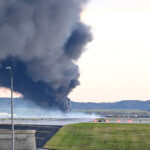Florida’s Insurance Commissioner Kevin McCarty has testified to a congressional committee in Washington, D.C. on the need for a national plan to respond to catastrophic events, and posed the question: “Is America’s Housing Market Prepared for the Next Natural Disaster?”
McCarty, who testified on behalf of the National Association of Insurance Commissioners, has been a vocal proponent of such a plan both as the state insurance commissioner and as chairman of both the NAIC’s Catastrophe Insurance Working Group and the Property and Casualty Insurance Committee.
“I do not think we can truly prepare the housing market for a mega-catastrophe without a comprehensive national strategy,” McCarty told the House Committee on Financial Service’s Subcommittee on Housing and Community Opportunity. “Insurance is only one of the critical components needed to truly provide a level of economic security in the face of catastrophic natural disasters for all Americans.”
“The committee has phrased today’s question succinctly, the problem is an economic problem, not simply an insurance problem,” McCarty said. “I have spent much of my professional career working on issues resulting from the economic effects of natural disasters, both before they occur as well as after they occur. As a result of these experiences, I firmly believe that insurance is a critical, but not complete, answer to our nation’s resilience in the face of catastrophic natural disasters. Insurance claim payments are the economic catalyst that restarts an affected region in the aftermath of a natural catastrophe. But, as experience repeatedly shows, pre-event disaster planning, effective mitigation and rational building codes are crucial parts of the solution.”
McCarty’s testimony focused on the role of insurance within the context of the question: “Is America’s Housing Market Prepared for the Next Natural Catastrophe?” If I were to try and offer a simple answer to this terribly important question, I am afraid that answer would have to be “maybe, up to a point.
“Today, the ability of housing markets, as well as local and regional economies, to withstand and recover from the next natural catastrophe depends critically on what type of peril creates the disaster, where the disaster occurs, and the severity of the disaster event,” the commissioner said. “The different types of natural disasters are managed very differently. This, in turn, can lead to highly different outcomes.”
According to McCarty, wind events, including tornados and hurricanes, are considered a basic covered peril in the vast majority of homeowner’s insurance policies. Flood, on the other hand, is only rarely written by the private insurance industry for residential property; since 1968 the National Flood Insurance Program has been the public solution to managing this risk. Finally seismic events, especially earthquakes, are not considered a standard covered peril, and aside from the California Earthquake Authority, there is no public mechanism to underwrite the risk, so coverage is restricted to being an optional coverage, where available, in the private insurance market.
“If the next natural catastrophe is a significant flood event, the ability of the affected housing markets and economies to endure and recover is going to depend critically on the degree to which affected properties were insured with the NFIP,” McCarty explained. “Unfortunately, recent evidence from 2004 and 2005 suggests that far too many properties damaged by flood were uninsured; either they were outside of the mandatory flood plains as dictated by antiquated maps, or they were in the mandated flood zones, but were uninsured anyway. A recent study by the Rand Corp. provides evidence that suggests that the rate of take-up (that is how often the coverage is purchased) outside of the mandated zones is around 5 percent, and the take-up rate in mandated zones is only about 75 percent.
“I know that there is pending legislation, both in this body and in the Senate, to improve and modernize the NFIP,” McCarty said. “I encourage you in your efforts, especially to create current risk assessment maps and tools, and to bring rationality into the pricing of flood insurance. An under-priced policy that does not accurately reflect the risk of the event only makes the economic problems associated with flood worse.
“If the next natural catastrophe is an earthquake, the ability of the affected housing markets regional economies to endure and recover is going to be dependent on the degree of disaster relief coming from the federal government. The reason is really quite simple; the majority of residential property in earthquake prone areas is not insured for this very real risk.
In California, for example, it is estimated that the take-up rate for optional earthquake insurance is about 14 percent. The same take-up rate is frequently suggested to be true in the earthquake prone areas in the Midwest’s New Madrid area, and along the eastern seaboard’s seismically active areas.
The economic results of a major earthquake could be disastrous. Consider a widely referenced recent study by Risk Management Solutions, a catastrophe modeling firm, which estimated the losses associated with a repeat of the 1906 San Francisco earthquake.
While much has been made of the reported estimate of $50 to $80 billion in insured losses, the much more disturbing number is an estimate of total property damage of around $260 billion. How will the majority of the damage be rebuilt without insurance? Without houses for people to live in and business for people to work in, how will the economy recover?”
Source: Florida Department of Insurance
Was this article valuable?
Here are more articles you may enjoy.

 Boeing 2011 Warning May Offer Clues into 2025 UPS Jet Crash
Boeing 2011 Warning May Offer Clues into 2025 UPS Jet Crash  Tesla, EEOC Plan Talks to Settle Factory Racism Suit
Tesla, EEOC Plan Talks to Settle Factory Racism Suit  Bayer Gets Supreme Court Hearing in Challenge to Roundup Suits
Bayer Gets Supreme Court Hearing in Challenge to Roundup Suits  What The Return of California’s ‘Death Discount’ Means for Litigation
What The Return of California’s ‘Death Discount’ Means for Litigation 